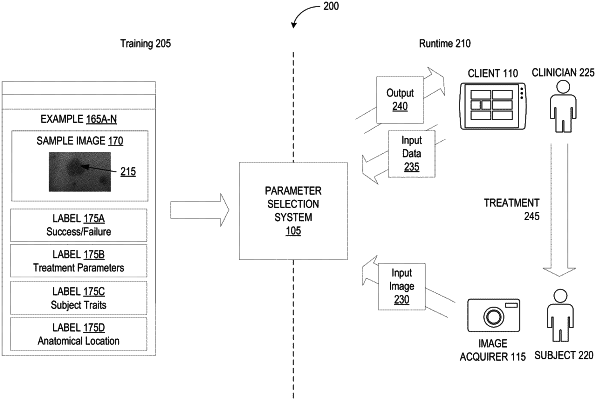| CPC G16H 50/20 (2018.01) [A61B 5/0013 (2013.01); A61B 5/0077 (2013.01); A61B 5/444 (2013.01); A61B 5/4836 (2013.01); A61B 5/4848 (2013.01); G06T 7/0012 (2013.01); G16H 20/10 (2018.01); G16H 30/20 (2018.01); G16H 30/40 (2018.01); G16H 50/50 (2018.01); A61B 2576/02 (2013.01); G06T 2207/20081 (2013.01); G06T 2207/30088 (2013.01); G06T 2207/30096 (2013.01)] | 17 Claims |

|
1. A method, comprising:
identifying, by one or more processors from an image acquirer, an input image corresponding to a skin lesion on a subject;
detecting, by the one or more processors, a presence of the skin lesion on the subject by applying a feature recognition model to the input image;
generating, by the one or more processors, responsive to detecting the presence of the skin lesion on the subject, (i) plurality of candidate treatments to apply, each of the plurality of candidate treatments defining one or more respective treatment parameters and (ii) a plurality of likelihoods of success corresponding to the plurality of candidate treatments, by applying a treatment parameter selection model to the input image, wherein the treatment parameter selection model is established by:
identifying a training dataset comprising a plurality of examples, each of the plurality of examples having i) a sample image of an example skin lesion, ii) a first label indicating an outcome of an application of a treatment, iii) a second label identifying one or more sample treatment parameters defining the application of the treatment to the example skin lesion,
iteratively inputting a respective sample image from the plurality of examples to generate a corresponding output, the corresponding output having an one or more expected treatment parameters and an expected outcome, and
modifying at least one weight of the treatment parameter selection model based on a comparison between the corresponding output from the treatment parameter selection model, and the first label and the second label for the respective sample image; and
selecting, by the one or more processors, at least one recommended treatment from the plurality of candidate treatments based on the plurality of likelihoods of success; and
storing, by the one or more processors, in one or more data structures, an association between the input image and one or more treatment parameters of the at least one recommended treatment to apply to the skin lesion corresponding to the input image.
|